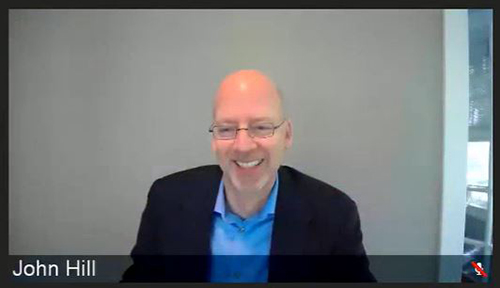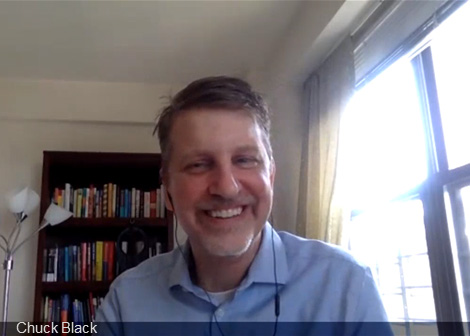Apart Yet Together: Virtual 2020 NSLS-II & CFN Users' Meeting
A record-breaking number of attendees gathered virtually at the NSLS-II & CFN Users' Meeting to discuss the most recent developments in photon science and nanoscience
June 26, 2020

Upton—From May 18 to 20, more than 1500 registered attendees from 37 countries around the world participated in the first-ever virtual joint Users’ Meeting of the Center for Functional Nanomaterials (CFN) and the National Synchrotron Light Source II (NSLS-II)—two U.S. Department of Energy (DOE) Office of Science User Facilities at DOE’s Brookhaven National Laboratory. Holding the annual joint Users’ Meeting is a long-standing tradition at Brookhaven Lab, where attendees enjoy scientific discourse during the warm spring days on Long Island.
While the Coronavirus pandemic limited the Lab’s ability to bring attendees on site for 2020, it presented a new opportunity for the conference organizers to hold a virtual Users’ Meeting, which attracted five times more attendees than ever before. The meeting included eight workshops, each held in a virtual meeting rooms with record-breaking numbers of attendees, ranging from 120 to more than 400. The meeting’s plenary session included more than 600 attendees listening and asking questions.
NSLS-II continues to support user science
For the plenary session of the meeting, the two Users’ Executive Committee (UEC) vice-chairs, Abram Ledbetter and Matthew Whitaker, welcomed the attendees from the virtual BlueJeans stage. In their brief speeches, the chairs conveyed their excitement about the large number of attendees, thanked the meeting’s sponsors, and welcomed the first speaker of the plenary session, NSLS-II Director John Hill.

During this year's presentation, NSLS-II Director John Hill presented an outlook for the next 10 years of NSLS-II.
Hill opened his presentation by addressing the current state of NSLS-II during the Coronavirus pandemic. “Midway through a very successful year, we have paused all operations except essential work aimed at combating COVID-19,” he said. “But this doesn’t mean we have stopped working on your science here. We remain open for science and for those of you who have already taken data at NSLS-II. So, I encourage you to work with our staff to understand that data - and to publish it!”
Hill used this opportunity to highlight the ongoing research into COVID-19 treatments at NSLS-II, provide updates on the NSLS-II accelerator, and convey the facility’s dedication to enhancing data management and analysis capabilities. Overall, Hill’s presentation looked towards a bright future for NSLS-II.
“We are developing a dedicated restart plan for our user program that ensures continued safe working conditions for all of us and will feature remote operations more heavily,” Hill said. “And even now, we continue to develop plans for the next 10 years. On the beamline side, we are working on the conceptional design for three new beamlines, while at the same time we are exploring upgrade options for the facility that will significantly improve our research capabilities.”
In thinking about the future, the goal is to optimize an entire experiment, not just the source. To achieve that, NSLS-II is looking at improving each component of any experiment by a factor of 10. Specifically, increasing the number of photons from the source by a factor of 10, reducing the number of photons lost from source to sample by a factor of 10 and improving the detection of photons coming from the sample by a factor of 10. Together, these will result in transformative advances in the science that NSLS-II will enable.
CFN strives to be a “thick” organization
The next plenary speaker was CFN Director Chuck Black, who opened his presentation by sharing the CFN values and mission: “At CFN, we believe in collaboration, we see challenges as opportunities, we strive for excellence—and we apply these values in service to user research. Our mission is to advance nanoscience through cooperation to benefit society.”

CFN Director Chuck Black gave an inspiring talk about the CFN's mission and values while also sharing news about the facilities research into COVID-19 and the new capabilities CFN added to their portfolio.
Black then spoke about “thick” organizations, as described by columnist David Brooks in a 2017 New York Times article. According to Brooks, a thick organization appeals to our desire to do good and leaves a mark on its members. Black explained how CFN strives to be a thick organization for both users and staff—with shared values, a common interest in pursuing a greater cause, a unique personality, and grit in the face of a crisis.
“In the current crisis, we have seen a lot of grit in America—in first responders, medical workers, postal and delivery people, bus drivers, and so many more—and now, it is time for scientists to win this fight, for everyone,” he said. “I am proud to be a member of the community of scientists. We are not on the sidelines of this fight. So, I encourage you to bring your best ideas so that we can develop them together—like we always do.”
Black referenced several ongoing CFN projects addressing COVID-19 from multiple angles, including models to understand how the virus spreads and nanoscience concepts for virus detection and therapeutics. He also described two capabilities recently added to the CFN microscopy suite—an environmental atomic force microscope and hyperspectral dark-field imaging microscope—and future automated nanomaterial synthesis platforms for quantum materials and DNA-mediated architectures.
Basic Energy Science shares its scientific priorities
The keynote speaker for this year’s plenary session was Linda Horton, Associate Director of Science for Basic Energy Sciences (BES) in DOE’s Office of Science. Horton expressed her gratitude for the opportunity to speak at the Users’ Meeting for “such vibrant programs at Brookhaven National Laboratory.”
“The previous talk [by Chuck Black] inspired me to reflect on my own experiences with thick organizations that brought me back to my time as the director of Oak Ridge National Laboratory’s nanocenter. This experience certainly shaped me in many ways. It helped me to greatly appreciate the users and their role in science, as well as the role of the user facilities in enabling us to reach new heights in research,” said Horton.
During her talk, Horton spoke about the Office of Science budget and the strategic direction for BES. She presented its research priorities as the following: quantum information science, Energy Frontier Research Centers, energy innovation hubs, computational materials and chemical sciences, microelectronics, and data analytics and machine learning for BES facilities.
Following the presentation, the three speakers came together for an extensive question and answer session with a highly engaged audience. This session was widely praised in the conference feedback form: “Excellent Q&A in the plenary session, perhaps the best I have seen in 10 years of Users' Meetings. Current events helped, but the online format makes people willing to ask good, interesting questions.”
Workshops achieve record-breaking numbers of attendees
Not only was the plenary session well attended, but the eight in-depth workshops were also lively with record numbers of attendees.
“Honestly, we did not expect this outcome,” said Gretchen Cisco, NSLS-II User Administrator, who organized the meeting together with Grace Webster, CFN User Administrator and the UEC vice-chairs. “When we made the decision to have a virtual meeting, we were worried that the workshops would be quiet with few questions or poorly attended. But thanks to all the workshop organizers—who really stepped up to make this meeting a success—the comments about the workshops were all positive. So, we would like to thank every workshop organizer for the time and dedication they brought to this year’s meeting. Thank you all!”
Additional information for each workshop, including abstracts and slides, can be found on the Users' Meeting website:
- Brookhaven Lab User Facilities 101: Techniques, Applications, and Access for the Beginner
- Measuring Protein Dynamics using Very High-Throughput Automated Micro-beam and Time-Resolved Micro-beam Macromolecular Crystallography
- 2-D and Quantum Materials: Emerging Phenomena, Device Fabrication and Applications
- Scientific Python for Data Analysis at NSLS-II
- The Universe Seen through a Microscope: Characterization of Extraterrestrial Materials using Synchrotron Probes
- Opportunities in Biosensing using New Nanotechnology Approaches
- Soft X-ray Scattering and Spectroscopy at NSLS-II: Gap Analysis
- Machine Learning in X-ray Imaging and Microscopy Applications – A Symposium with Hands-on Demonstrations
As a result of the attendees’ positive feedback about the virtual format, the NSLS-II and CFN user committees are considering adding a virtual component to future meetings. NSLS-II and CFN look forward to hosting their next joint Users’ Meeting in 2021.
The two Users’ Executive Committees would like to thank all sponsors of the 2020 joint User’s Meeting.
Brookhaven National Laboratory is supported by the Office of Science of the U.S. Department of Energy. The Office of Science is the single largest supporter of basic research in the physical sciences in the United States, and is working to address some of the most pressing challenges of our time. For more information, please visit science.energy.gov.
Follow @BrookhavenLab on Twitter or find us on Facebook.
2020-17273 | INT/EXT | Newsroom









